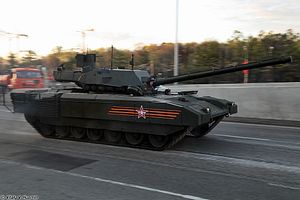The first major tank to be developed in Russia since the collapse of the Soviet Union abruptly grounded to a halt during a rehearsal for Moscow’s big May 9 Victory Day parade, Reuters reports.
The incident occurred yesterday during the final dress rehearsal of the highly anticipated 2015 military parade in Red Square, commemorating Soviet Russia’s victory over the German Third Reich in the Second World War. The parade is expected to involve 16,000 troops, 145 aircraft, 190 armored vehicles and a number of new missile systems (see: “‘Arma Virumque Cano’ – Parades and Militarism in Asia”).
According to the Moscow Times, one of eight T-14 — the world’s first series-produced third generation main battle tank, based upon the new Armata universal chassis system — suddenly stopped in front of the GUM department store while crossing Red Square with its engines still rumbling.
Attempts to tow the tracked vehicle as the rest of the armored column passed by proved unsuccessful, yet the tank began to move on its own 15 minutes later. Loudspeakers immediately announced that the sudden stop had been planned. “We have demonstrated how the evacuation of military hardware [during battle] will be conducted. The tank’s stop was planned,” the parade’s announcer told curious spectators.
Furthermore, Reuters reports that Alexei Zharich, deputy general director of the Uralvagonzavod factory — the largest main battle tank manufacturer in the world — noted on Twitter that the Russian Armed Forces were responsible for the parade rehearsal but stressed that the tank “was functioning properly and left on its own power.”
As I noted two weeks ago, the T-14 main battle tank (MBT) is “the crown jewel of Moscow’s future tank force.” Its new design constitutes in many ways a clear break with old Soviet-era military hardware “and represent the biggest change in Russia’s armored fighting vehicle families since the 1960s and 1970s,” IHS Jane’s Defense Weekly reports.
The T-14 Armata’s key feature is its unmanned remotely controlled turret (see:“Putin’s New ‘Wunderwaffe’: The World’s Deadliest Tank?”), and the location of the crew in an armored capsule in the forward portion of the hull. It also boasts a new automated ammunition feed system.
Additionally, as I reported before, the Russian military envisions the universal Armata chassis system as a platform for as many as 13 different tracked vehicles, including a self-propelled artillery platform, an armored military engineering vehicle, and an armored personal carrier.
The Russian military intends to replace 70 percent of its tank corps with the new tracked vehicle and plans to produce 2,300 T-14 Armata models by 2020 (see: “Revealed: Russia’s Deadly New Tank Force”).
































